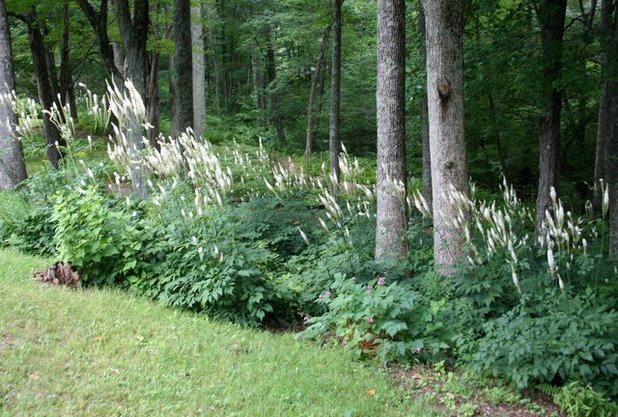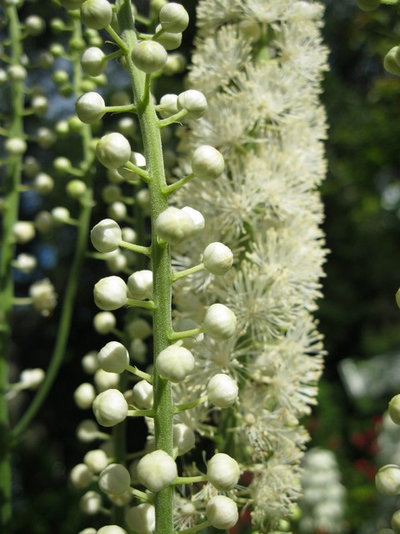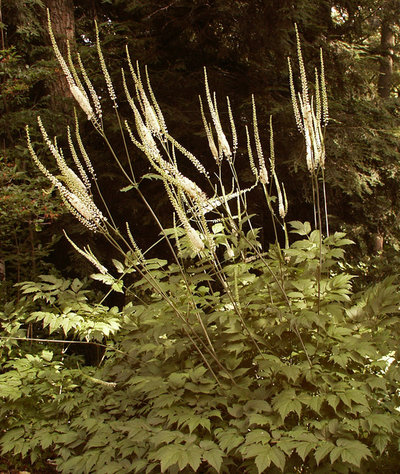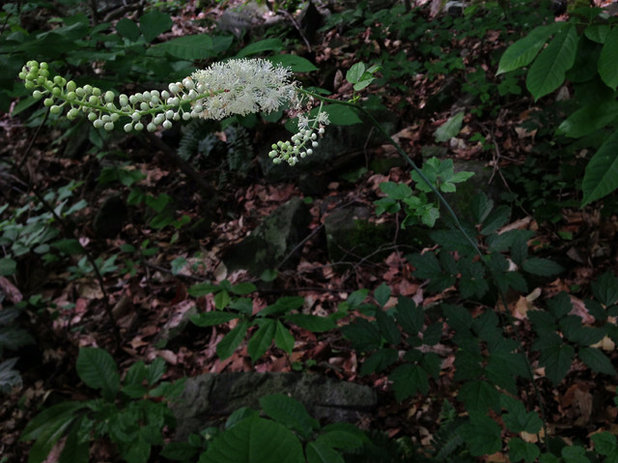There are so many reasons for eastern U.S. gardeners to grow black cohosh (
Actaea racemosa). One of the few summer-blooming plants that grow in shade, it has tall and elegant white candlestick flowers that contrast beautifully against a green woodland background. Its flower nectar attracts all kinds of butterflies, pollinators and other nonaggressive beneficial insects. It’s also disappearing from its natural habitat.
Black cohosh is used as an herbal alternative to hormone replacement therapy, and wild populations are at risk due to illegal harvesting for sale to the worldwide botanic market. If you have an area with some shade and a moist woodland-type soil, grow some black cohosh to help protect this wild plant’s beauty and value for future generations.

Ellen Sousa/Turkey Hill Brook Farm
 Botanical name: Actaea racemosaCommon names:
Botanical name: Actaea racemosaCommon names: Black cohosh, black bugbane, black snakeroot, fairy candles
Origin: Native to rich deciduous woodlands from Massachusetts south to Georgia and west to Missouri and Arkansas
Where it will grow: Hardy to -40 degrees Fahrenheit (USDA zones 3 to 9; find your zone)
Water requirement: High
Light requirement: Partial sun to full shade
Soil requirement: Grows in moist, well-drained soils high in organic matter
Mature size: Foliage reaches 2 feet tall and 3 to 4 feet wide; flower spikes grow 5 to 6 feet tall
Benefits and tolerances: Tolerates even, heavy shade; fairly deer resistant; popular nectar plant for pollinators and beneficial insects; gnarly roots and rhizomes have many medicinal uses
Seasonal interest: Feathery white flower wands in summer with a musky fragrance that draws pollinators; highly textured, dark green foliage mingles well with that of other low woodland plants
When to plant: Plant rhizomes in spring or fall, mulch well with leaves or wood chips, and provide plenty of water in the first year.
Photo by Vincent Normand

Ellen Sousa/Turkey Hill Brook Farm
Distinguishing traits. Closely related plants include the Southeast native American bugbane (
Actaea americana) and Appalachian bugbane (
A. rubifolia), both of which have similar flowers to
A. racemosa but bloom in fall.
Look for black cohosh at native plant nurseries, but check labels carefully. Formerly known as
Cimicifuga racemosa, black cohosh now belongs to the
Actaea genus, but you may still find plants labelled as
Cimicifuga as the new name phases into nursery use.
Actaea cultivars, such as the dark-leaved ‘Brunette’, may be labeled
A. simplex,
A. atropurpurea or
A. ramosa, but these species are of Asian origin and their roots and rhizomes don’t have the same medicinal value as the native
A. racemosa.How to use it. Plant a native herbal shade garden by growing black cohosh with American ginseng (
Panax quinquefolius), goldenseal (
Hydrastis canadensis), bloodroot (
Sanguinaria canadensis) and wild ginger (
Asarum canadense) underneath existing trees such as oaks (
Quercus spp), maples (
Acer spp) or hemlocks (
Tsuga spp).
Add spring color with foamflower (
Tiarella cordifolia), Virginia bluebells (
Mertensia virginica), trout lily (
Erythronium americanum), Solomon’s seal (
Polygonatum spp), wild phlox (
Phlox divaricata,
P. stolonifera) and wild geranium (
Geranium maculatum), for a beautiful shade garden that will naturally fill in over time by spreading and self-seeding.
 Planting notes.
Planting notes. Black cohosh grows best in moist soil in a spot where it can receive at least a few hours of daily sunshine, preferably in the morning. It will grow in full shade, but blooming will be more sparse. An east-facing woodland edge is a perfect spot.
Propagation: Difficult to grow from seed, black cohosh has seeds that require several warm-cold-warm cycles before they germinate. Collect the seeds in early fall when the seedpods begin to open and you can hear the seeds rattle inside. Do not allow the seeds to dry out. Remove them from their pods and immediately sow them in a container filled with a woodland plant seedling mix. Place the container outdoors until the following spring to expose the seeds to multiple chill-thaw cycles, or immediately place the container in a room heated to 70 degrees Fahrenheit for at least three months, making sure the soil stays moist throughout, and then move the container outdoors in spring.
Division: Although division is rarely necessary, black cohosh is easy to divide from existing plants. Cut rhizomes into 2- to 3-inch sections — with at least one bud per section. Leave all the thin, fibrous roots attached to the rhizomes. Replant the rhizomes and cover them with 2 inches of soil. Mulch heavily with shredded leaf mulch, leaf mold or partially decomposed wood chips, and water well for the first year.
Harvesting: Harvest roots and rhizomes in fall from established plants with large rhizomes. Seed-grown plants take four to six years for the roots to be harvestable.
Never harvest roots from wild populations unless you have a permit or permission from the landowner. Not only is wild harvest against the law in the U.S., but illegal poaching has severely depleted historical wild populations in many areas of the South. Help reduce pressure on at-risk wild populations by growing black cohosh at home. Buy cohosh plants from your local native plant nursery (which should sell plants of local provenance) to preserve genetic diversity within your local native populations, and allow the plant to self-seed. Seedlings can be moved around, or pot them up and give them to a garden friend.
Photo by Fritz Flohr ReynoldsMore:A Great Spring Plant Combo for Dappled Shade
Learn more about gardening with native plants in your area





